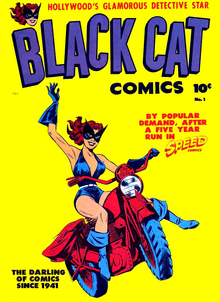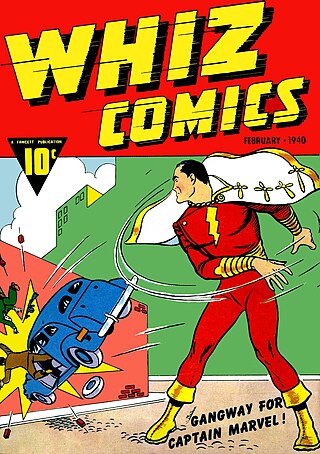
A superhero or superheroine is a stock character who typically possesses superpowers or abilities beyond those of ordinary people, is frequently costumed concealing their identity, and fits the role of the hero; typically using their powers to help the world become a better place, or dedicating themselves to protecting the public and fighting crime. Superhero fiction is the genre of fiction that is centered on such characters, especially, since the 1930s, in American comic books, as well as in Japanese media.
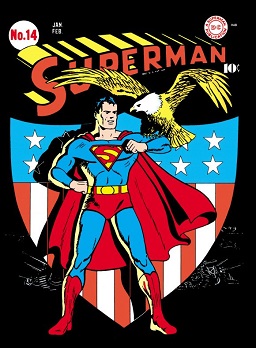
The Golden Age of Comic Books describes an era in the history of American comic books from 1938 to 1956. During this time, modern comic books were first published and rapidly increased in popularity. The superhero archetype was created and many well-known characters were introduced, including Superman, Batman, Robin, Captain Marvel, Captain America, and Wonder Woman.
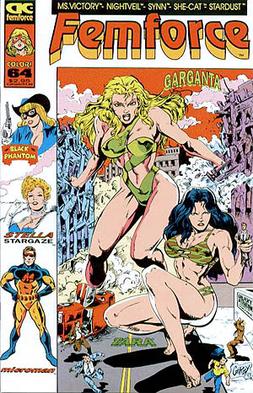
Femforce is a comic book published by AC Comics that began publication in 1985, detailing the adventures of the titular team: the "Federal Emergency Missions Force" or "Femforce", some of them original creations, while others originated in the 1940s and 1950s, lapsing into the public domain by the time Femforce was published. The team are, as their name implies, all superheroines, and are the first and the longest running all-women 'super-team'. The series has passed 200 issues, a significant milestone for an independent comic book company. Writers on the book have included Bill Black, Stephanie Sanderson, Mark Heike, Paul Monsky, Enrico Teodorani and Francesca Paolucci. Artists on the book have included Bill Black, Stephanie Sanderson, Mark Heike, Brad Gorby, Jeff Austin, Dave Roberts and Rik Levins.
Black Fury is the name of several fictional comic book characters published in the Golden Age of Comics.
Alfred Harvey, was the founder of comic book publisher Harvey Comics and the creator of the comic book characters Little Dot, Richie Rich, and Adam Awards. He was born to Russian Jewish immigrants in Brooklyn, New York. Alfred Harvey's company, Harvey World Famous Comics, produced comic books and cartoons featuring Wendy the Good Little Witch, Spooky the Tuff Little Ghost, Casper the Friendly Ghost, Baby Huey, Little Audrey, and Little Dot. It also published Sad Sack, the military comic strip, which was created by George Baker.
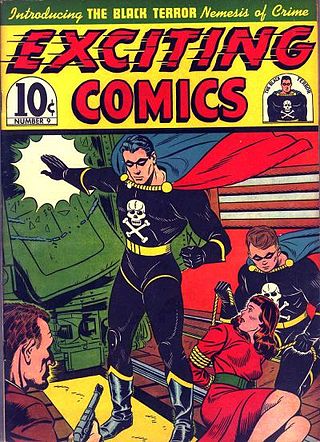
The Black Terror is a fictional comic book superhero who originally appeared in Exciting Comics #9, published by Nedor Comics in January 1941. The character was popular, and on the strength of the Black Terror's sales, Nedor made Exciting Comics a monthly magazine starting with issue #11.

Cat-Man and Kitten are a pair of fictional superhero characters created by artists Irwin Hasen (Cat-Man) and Charles M. Quinlan (Kitten) with unknown writers. Cat-Man was first published in 1940 by various Frank Z. Temerson companies. Due to circumstances during World War II, an altered version of Cat-Man was published in Australia and reprinted in the 1950s. AC Comics later revived the characters in the 1980s.

Daredevil is a fictional superhero created by Jack Binder, who starred in comics from Lev Gleason Publications during the 1930s–1940s period historians and fans call the Golden Age of comic books before being retroactively established into the Image Universe by Image Comics in the 1990s as its first character. The character is unrelated to Marvel Comics' Daredevil, and recent renditions of the character have often renamed him Doubledare or The Death-Defying Devil to avoid confusion and potential lawsuits.

All-American Publications, Inc. was one of two American comic book companies that merged to form the modern-day DC Comics, one of the two largest publishers of comic books in the United States. Superheroes created for All-American include the original Atom, Flash, Green Lantern, Hawkman, and Wonder Woman, all in the 1940s' Golden Age of Comic Books.

Captain Flag is a superhero created by MLJ Comics' writer Joe Blair and artist Lin Streeter. He first appeared in September 1941, in issue #16 of Blue Ribbon Comics. He continued until the last issue, Blue Ribbon Comics #22.

Nyoka the Jungle Girl is a fictional character created for the screen in the 1941 serial Jungle Girl, starring Frances Gifford as Nyoka Meredith. After the initial film, Nyoka appeared in comic books published by Fawcett, Charlton, and AC Comics.

Yankee Girl is the name of two superheroines each debuting during the 1930s and 1940s Golden Age of Comic Books. One was revived in the 1990s.
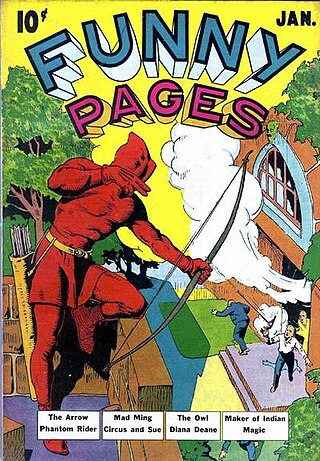
The Arrow is a fictional superhero created during the Golden Age of Comic Books. He was the first superhero published by Centaur Publications.
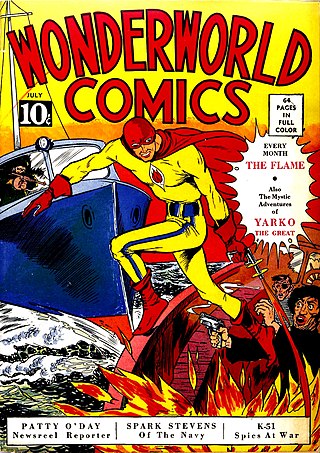
The Flame is a superhero that appeared in American comic books published by Fox Feature Syndicate. The Flame first appeared in Wonderworld Comics #3 and was created by writer Will Eisner and artist Lou Fine. The Flame became Wonderworld's primary character.
Alfred J. Gabriele was an American comic book artist during the 1940s period fans and historians call the Golden Age of comic books. He was known for his work on some of Marvel Comics' earliest Captain America and Sub-Mariner stories, and for co-creating the company's superheroes Black Marvel, Miss America, and possibly, the Whizzer.
The portrayal of women inAmerican comic books has often been the subject of controversy since the medium's beginning. Critics have noted the roles of women as both supporting characters and lead characters are substantially more subjected to gender stereotypes, with femininity and/or sexual characteristics having a larger presence in their overall character.

Shock Gibson is a fictional comic book superhero who first appeared in Speed Comics #1, from Brookwood Publications. He was created by artist Maurice Scott, who drew it through issue #11, and an unknown writer. His 1939 introduction makes him one of comic books' earliest superheroes. He also appeared in All-New Comics #8.
Yank & Doodle is a pair of superheroes who first appeared in the Prize Publications title Prize Comics in August 1941. They were revived by Dynamite Entertainment in the 2000s.

The Spirit of '76 is a fictional superhero character published by Harvey Comics, who debuted in Pocket Comics in 1941, and became a long-running feature in Green Hornet Comics.
